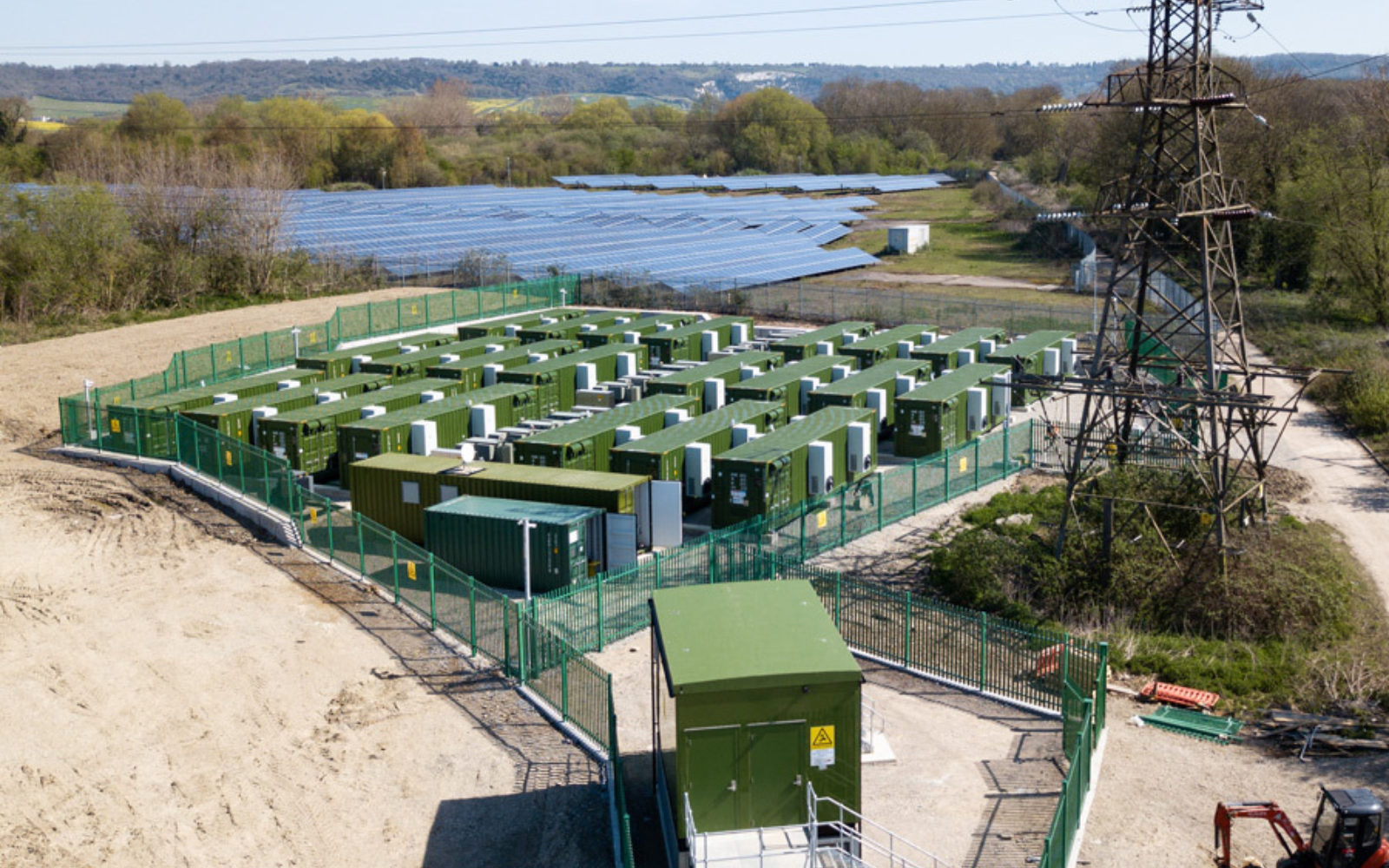Power markets are evolving and beginning to value flexibility ahead of generation. As the UK’s networks companies move to embrace flexible generation assets, Liam Stoker spoke to some of the country’s leading providers to identify the hurdles and solutions to a more flexible power grid, in an article first published in PV Tech Power Volume 20.

The UK’s power sector is evolving at such a rate that generators, grid operators and utilities alike can scarcely believe the rate of change. It seems a new renewable energy record tumbles each week, with coal falling off the grid for large parts of the year already.
While this is unquestionably good news, it’s left the country’s transmission and distribution network operators (DNOs) in something of a quandary. There is now a clear and present – and some might add urgent – need for far greater quantities of flexible generation to both balance the grid and offset the need for more costly reinforcement works. A power market that once valued generation above everything now considers flexibility worth its weight in gold or, indeed, lithium-ion.
The networks have been proactive in this regard, and have taken to sourcing their own flexibility. Localised tenders have been introduced, helping connect with owners and operators of flexible assets to ease distribution-level grid constraints. Having tentatively explored the market for such auctions in 2018, DNOs are now transferring flexibility markets into business-as-usual activities, and using them to future-proof large sections of the grid.
But in some locations, the market appears at an impasse. Flexibility is a resource in demand, but providers are either shying away from tenders or simply do not have the projects required, nor the economic business case to build.
In order to address this shortfall, PV Tech Power / Energy-Storage.news sister publication Current± collaborated with the UK’s Energy Networks Association and assembled 16 of the UK’s leading flexibility providers, aggregators, asset optimisers and energy technology firms to determine precisely what hurdles the flexibility market still faced and, crucially, how the sector could overcome them.
 Better data is needed to identify network constraints where, for example, battery projects would help ease congestion. Image: Zenobe Energy.
Better data is needed to identify network constraints where, for example, battery projects would help ease congestion. Image: Zenobe Energy.
A transparent need
One of the significant hurdles raised by market operators spoken to was a distinct lack of necessary data and transparency on the part of the DNOs. At present, data that is shared with the market pertaining to possible areas of curtailment is limited to where the congested areas are today, and is given in broader times.
That, a number of companies said, simply wasn’t good enough for them to be able to build a business case robust enough to stand up a new battery storage project or other generating assets. “Data is absolutely key,” said Mark Tarry, chief financial officer at asset developer AMP, adding that network operator’s Long Term Development Statements – which formally document areas of works – are limited in their scope to areas of constraint today. “What you can’t do is try and estimate where the areas of constraint will be in two, three or five years’ time, and that is what is important,”Tarry said.
This is significant for project lead times, particularly if there is any involvement from a community energy group or other party such as a landowner, as is frequently the case in the UK power sector. Identifying an appropriate site, conducting due diligence, negotiating lease fees, agreeing contract terms, building a bankable business case, pursuing and sealing planning permission, gaining a grid connection agreement, and all the associated procurement, engineering and construction works mean it can be years before a project can get off the ground. Jo-jo Hubbard, founder at blockchain specialist Electron, concluded that time remained amongst the biggest challenges across the board for small-scale flexibility assets. It’s evident that even the most nimble and expedient of project developers cannot move fast enough for the status quo.
James Basden, founder and director at battery storage developer Zenobe, echoed Tarry’s sentiments, commenting that transparency surrounding data, particularly those relating to networks and areas of constraint, needed to be drastically improved.
“If we can see what the potential is to get in and put new flexibility assets on [to the grid], whether there is a rate of return that’s acceptable... looking at how different technologies could be a better solution than conventional grid reinforcement, it’s something that could be really very interesting... but it’s almost impossible get hold of that data,” Basden said.
And when that data is forthcoming, it might not even be particularly useful. Tarry spoke of a time when he was shown constraint information – essentially the projected load versus the capacity – of a particular substation in the UK. In order to forecast how that load may develop over time, the DNO in question had applied a generic growth rate of 1%, something it had applied universally across its licensed network.
That substation was already at 80% of its capacity, but what the DNO had failed to factor into its forecasting was that, next door, a new business park was to be built under the premise of creating 15,000 jobs. Not only that, but a considerable factor of that development’s sustainability credentials was the addition of electric vehicle chargers, contributing to what would have been a sizeable addition to the load on that substation. That information had been in the public domain, and could have been used intelligently by the DNO to create a more accurate, forward-looking picture of future constraint.
The solution, according to our panel, is for the DNOs to ramp up their efforts when it comes to data and transparency. If the network operator can forecast constraint zones two to five years in the future, then these forecasts should be forthcoming to take into account the inevitable lag in project lead times.
Furthermore, the data provided needs to be far more granular than is currently on the table. If such constraint data was to be made available on a substation-by-substation basis, then project developers would be able to pinpoint precisely the areas of need, and target their services more accurately than is currently the case.
This point becomes all the more salient when network charges are taking into account, and how this level of granularity could be adopted into the densely complicated area which is network charging, and used to great effect.
Charging forward
The UK’s network infrastructure is essentially owned by monopolies regulated by the country’s regulator Ofgem, meaning that their respective revenues are tightly controlled. This is achieved through network charging, which is essentially a cost levied against generators and suppliers in order to transmit and distribute power via the country’s cables and lines. These charges are many and complex, and subject to a significant ongoing review.
The aforementioned Ofgem is facing a quandary; how to evolve those charges alongside a changing energy system, while maintaining their impartiality and equality. It’s something the energy sector remains split on, and Ofgem has been on the end of some stern criticism surrounding recent proposals that the flexibility industry has warned could render large numbers of projects uneconomical.
The panel of flexibility providers assembled was unequivocal that uncertainty stemming from Ofgem’s charging reviews had hindered flexibility projects coming forward, but were equally certain that, with a few minor tweaks, they could be used as a signal within areas of constraint that flexibility projects, and services, are needed.
These tweaks divided the room, representing the difficult nature of Ofgem’s job. Conor Maher-McWilliams, head of flexibility at Kaluza, which is part of the OVO Group, said that price signals could be broadcast through network charging opportunities – essentially making it cheaper to operate a flexible generation asset than it might otherwise have been – pre-empting an overloaded substation and direct procurement.
Network charges could stand to be an ideal way of incentivising flexibility asset development and indeed targeting it, but nothing does the trick quite like a market auction, as the network operators have already established.
Markets and contracts
When it comes to how best to procure flexibility, timing once again rears its head. Melanie Ellis, head of regulatory affairs at aggregator Limejump, said that it was critical that project lead times are taken into account when tendering for services. There’s no point tendering for flexibility for six months’ time in an area where there’s little existing flexible generation, for example.
It’s also critical that the contract lengths on offer remain diverse. Long-term contracts are perfect if projects need financing – nothing quite sates a financier like multiple years of predictable revenues – but locking a sizeable battery, for example, into four years of having to be available during peak times, when revenues and values may well shift elsewhere, could dissuade operators from taking the plunge. Claire Addison, head of regulation at Flexitricity, said there was a “spectrum of views” when it came to contract lengths.
Handing out lengthy contracts can also negatively impact market liquidity. Locking in sizeable contracts for years at a time could limit availability in future years and, as a result, prevent new projects from coming forward.
There is also something of a split between what asset owners want and what DNOs need. Owners, as Hubbard says, need to be able to have explicit, concrete guarantees that they can provide flexibility in return for revenues and if there are non-delivery penalties, then a clear idea of what those are precisely. Network operators on the other hand simply need to know that there’s enough flexibility on the network in the near future to balance should the need arise.
Given the considerations at hand, the network operators face a Goldilocks-esque dilemma when it comes to procuring flexibility. One such possibility mooted by the panel would require more of the previously highlighted transparency, but would exhibit the direct value flexible generators can provide. If, for instance, a network was considering traditional reinforcement works, said network could publish its cost expectations and the additional capacity to be delivered, and invite flexibility providers to compete against those parameters. Basden was convinced that in doing so, it would be “fairly rare to find a case where the battery doesn’t outperform the reinforcement”.
If the data were more granular, network charging reformed to send the initial signal and the products designed in the correct way, then all that’s left is to properly engage, both with flexibility providers, communities and consumers.
 Flexitricity control room. There's a “spectrum of views” when it comes to contract lengths, the company's head of regulation, Claire Addison, said. Image: Flexitricity.
Flexitricity control room. There's a “spectrum of views” when it comes to contract lengths, the company's head of regulation, Claire Addison, said. Image: Flexitricity.
But even that isn’t as straight forward as it may first appear.
Prior engagements
There is a stated desire for community energy groups to be brought into the fold when flexibility is procured, given their inherent engagement with the very communities the DNOs serve. These are often made up of likeminded individuals who have a passion for renewable electricity, but not necessarily the expertise to see a project through. As a result, these groups are likely to need a broader spectrum of support, be it financial, legal or technical, when it comes to bidding into flexibility markets.
There needs to be a greater degree of “hand holding” in the early stages of project development, Flexitricity’s Claire Addison said, which could take the form of a series of case studies or successful project examples. That way, rather than having to navigate the complicated UK energy market on their own, community groups could assess which project or case study more closely resembles their own and simply follow a (hopefully) well-trodden path.
Then it becomes a case of engaging with perhaps the least engaged party of all: the consumer.
The UK power market isn’t exactly famed for its consumer-centric approach. Since it was privatised in the 1990s, the energy retail space in the UK has treated consumers more like assets than valued customers, much to the chagrin of consumer groups and politicians alike. A cap on what energy companies could charge customers on standard tariffs, enacted at the start of 2019, has only served to complicate relations further.
But there are signs of hope on the horizon. A number of trials which involve bringing consumers into demand-side response markets have been successful, and energy companies are now waking up to the inherent value of having hundreds of thousands of informed and engaged customers.
Maher-McWilliams, whose parent company could be about to become the UK’s second-largest energy supplier, is vocal in his support of equipping consumers with all they need to enter such markets – both hardware and otherwise – and then ensuring that the benefits are shared with them.
It would appear that while it’s the DNOs that ultimately need the flexibility, and indeed should bear some responsibility in consumer engagement and education, the relationship ultimately lies with the provider of energy supplier. The DNOs should therefore be more concerned with ensuring the market framework is correct, enabling their participation in the first place.
“We as aggregators need to work out ways of sharing the benefits with domestic consumers by letting them know up front what those benefits might be,” Addison said, adding that it’s not just those that are presently engaged that need convincing. “Early adopters aren’t going to tip the dial and you need engagement with a broader spectrum of customers, and much more concrete ways of sharing the financial benefit.”
Flexibility is a nascent market for the UK power sector, so enamoured as it has been with generation, to consider. But it is nevertheless coming to terms with the new energy paradigm and flexibility markets are opening up across the country, from the Shetland Isles in the north to Cornwall’s south coast.
There are undoubtedly lessons to learn and regulations to be tweaked, but this is a sector that’s as much as a learning curve for network operators and regulators alike. If these adjustments can be made, flexibility could be on the cusp of a transformative boom.
The GenGame example
Over the course of two years, more than 2,000 of Northern Powergrid’s customers in the north east of the country shaved an average of 11% off their electricity consumption simply, principally by playing a game developed by gamification firm GenGame.
Downloaded to mobile devices via Facebook, the game communicated with devices installed in homes which monitored consumption. During periods of high demand on the grid, GenGame prompted players to reduce their consumption in return for points, which were used each month in order to increase their chances of winning portions of a £350 cash prize.
Northern Powergrid assessed the responses, and found that while the average customer turned down to the effect of 305W, some consumers managed to switch off as much as 4.9kW by switching off their EV chargers, for example.
The premise behind the game is simple, according to GenGame chief executive Stephane Lee-Favier. A consumer might only save 10p by turning their washing machine on at a less convenient time, but if doing so could help them win as much as £100, then that stands to be far more successful at incentivising behavioural change.